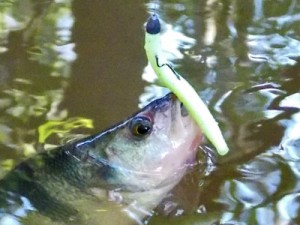
Weights used in freshwater fishing include egg sinkers, split shot, bullet weights, slip sinkers, drails, bottom fishing sinkers, and other tackle.
Weights and sinkers are used to control the depth of lures and to increase casting distances. When fishing live or cut baits, weights and sinkers help the angler maintain baits in the strike zone.
Line Weights
Several types of weights for fishing either attach to the line or have a hole that allows lines to pass thru. These include split shot, clamp-on, rubber core, egg, bullet, and torpedo designs. These weights are typically used for drifting live and cut baits or for casting artificial lures.
Split shot, rubber core and clamp-on weights are often used under a bobber or when a small amount of weight is needed. These three designs grip the line and do not move during fishing. Of the three types, the rubber core design is the most versatile because it can be re-positioned easily. Other types are crimped on with pliers and are useful only once.
Bullet weights are most often used when fishing artificial worms, although they have other applications. These hydrodynamic weights have several advantages. Their shape makes them cast well, retrieve easier and enables them to be fished among obstructions with less likelihood of getting snagged.
Bullet weights can be allowed to slide freely or can be fixed in place using a number of methods. The simplest Texas rig uses a classic bullet sinker. To set the weight in place, a toothpick is thrust into the center hole and broken off in place which prevents the weight from moving along the line.
A variety of variations are available, including weights that use a small cork screw type device to attach to the plastic lure. Other rigs for fishing artificial worms combine the hook and weight into a single unit.
Inline Weights
Inline weights use some method of connecting the line at each end. These weights are used for primarily for drifting in mid-depths or for trolling baits or lures. Depending on the application, inline weights may be located from 3 to 50 feet or more from the bait or lure.
The simplest of inline weights are torpedo shaped, with brass rings at either end. These weights allow anglers to connect lines directly to the weight, either by knots, crimps or thru the use of snap-swivels.
More evolved inline weights (drails) offer better methods for connecting lines. For example, some weights have built in swivels and/or special keels which limit line twist. These weights are engineered specifically for trolling and offer better control of line twist.
Sinkers
These weights located at the very end of the line. Sinkers come in a variety of sizes, shapes and variations, with each style having a specific use. The most common are simple, one piece bank sinkers.
Other designs feature an inset ring or swivel for attaching leaders. Other variations involve the shape of the sinker, with teardrop, disk, pencil, slip sinker, ball, and pyramid shapes being among the most widely used.
Weight – Sinker Selection
Regardless of the fishing technique being used, weight selection is critical to success. Weights that are too small will not have the required effect while oversized weights may spook fish or suppress the action of baits and lures. As water depth, current and bait sizes vary, weights may have to be adjusted accordingly during an outing.
Some sinkers have specific applications. For example slip sinkers allow anglers to drift or slowly troll baits over rocks or other obstructions.
A number of specialized sinkers are used for carp fishing. One of the most popular designs is a concave disk used for catching carp. Anglers conceal a baited hook within a ball of dough which is molded onto and around the disk sinker. Other carp fishing designs include small enclosures that contain attractants.